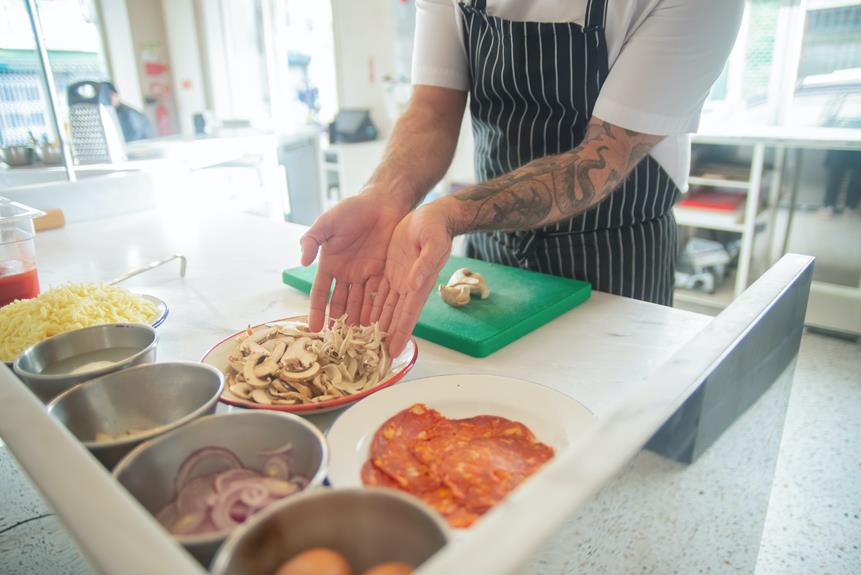Do you ever feel guilty when your furry companion stares at you with those big, longing eyes as you indulge in a slice of mushroom pizza? Well, let us tell you something that might surprise you.
Cats and mushrooms don't make the best dining partners. Contrary to popular belief, mushrooms can be harmful to your feline friend.
In this article, we'll explore the potential risks and health benefits of feeding cats mushrooms, as well as safer alternatives to satisfy their cravings.
Understanding a Cat's Dietary Needs
Understanding a cat's dietary needs is essential for ensuring their health and well-being. Cats are obligate carnivores, which means they require a diet that's high in animal protein. Their bodies are designed to efficiently digest and metabolize meat, making it a crucial component of their nutrition.
Meeting cats' dietary requirements involves providing them with a balanced diet that includes high-quality animal protein, essential fatty acids, vitamins, and minerals. Commercial cat food formulated specifically for feline nutrition is recommended, as it's formulated to meet their specific nutritional needs.
It's important to avoid feeding cats a diet primarily consisting of plant-based foods, as they lack certain essential nutrients that cats need for optimal health.
Potential Risks of Feeding Cats Mushrooms
Feeding your cat mushrooms from pizza can pose potential risks to their health. While some mushrooms are safe for cats to consume, there are several toxic varieties that can cause serious harm. It's crucial to be aware of the risks associated with feeding cats mushrooms and to prevent accidental ingestion. Here are some key points to consider:
- Risks of toxic mushrooms: Certain mushrooms contain toxins that can be harmful or even fatal to cats. These include Amanita species, which can cause severe liver damage, and certain wild mushrooms that may contain toxins that affect the nervous system.
- Symptoms of mushroom poisoning: If your cat consumes toxic mushrooms, they may exhibit symptoms such as vomiting, diarrhea, abdominal pain, lethargy, jaundice, seizures, or even coma. It's important to seek immediate veterinary attention if you suspect mushroom poisoning.
- Prevention is key: To keep your cat safe, it's best to avoid feeding them any mushrooms, especially wild ones. Additionally, be cautious when ordering pizza with mushrooms and ensure that your cat doesn't have access to any leftover slices.
Health Benefits of Mushrooms for Cats
While mushrooms from pizza may pose potential risks to your cat's health, it's important to understand the potential health benefits that certain mushrooms can provide.
Mushrooms aren't only a delicious addition to human meals, but they also offer numerous health benefits. Some mushrooms, such as shiitake and maitake, contain compounds that can boost the immune system and have anti-inflammatory properties. These benefits could potentially extend to cats as well.
However, it's crucial to note that not all mushrooms are safe for feline consumption. Some mushrooms, like the toxic varieties found in the wild, can be extremely harmful to cats and should always be avoided.
If you're considering incorporating mushrooms into your cat's diet, it's best to consult with your veterinarian to ensure you're choosing safe and suitable options.
How to Safely Introduce Mushrooms to Cats
To safely introduce mushrooms to your cat, you should start by gradually incorporating small amounts into their diet. Cats have sensitive digestive systems, so a gradual approach is essential to monitor their reactions. Here are some steps to follow when introducing mushrooms to your cat:
- Begin by finely chopping a small amount of mushrooms and mixing them with their regular food.
- Monitor your cat's behavior, appetite, and stool for any adverse reactions.
If your cat tolerates the mushrooms well, gradually increase the amount over time.
Alternatives to Pizza Toppings for Cats
For a cat-friendly alternative to pizza toppings, consider incorporating ingredients such as cooked chicken or fish into your feline friend's meal. These protein-rich options can provide a tasty and nutritious alternative to mushrooms or other potentially harmful pizza toppings.
Additionally, you can add cat-friendly vegetables to enhance the nutritional value of your cat's meal. Some examples of cat-friendly vegetables include steamed carrots, peas, or green beans, which can be chopped into small, bite-sized pieces to make them easier for your cat to eat. These vegetables can add variety and texture to your cat's meal while providing essential vitamins and minerals.
Alternatively, you can also make homemade cat treats without mushrooms by using ingredients like canned tuna or salmon mixed with cat-friendly grains such as oat flour or brown rice flour.
Remember to consult with your veterinarian to ensure that any new additions to your cat's diet are safe and appropriate for their individual needs.

